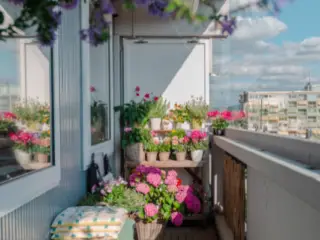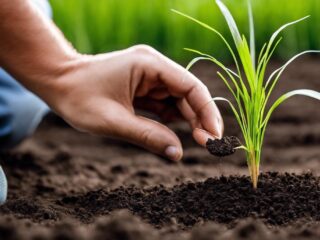Living in the city doesn’t mean you can’t enjoy the beauty of nature. With the right selection of balcony plants, you can transform your urban space into a lush, green oasis. Here are some of the best plants to consider.
1. Geraniums
Geraniums are a classic choice for balconies. They are hardy, easy to care for, and come in a variety of colors. Plus, their lovely scent can help mask any city smells.
2. Lavender
Lavender is another excellent choice for a balcony garden. It’s a hardy plant that can withstand full sun and has a beautiful, calming scent. Plus, it’s a great plant for attracting pollinators like bees and butterflies!
3. Tomatoes
Yes, you can grow tomatoes on your balcony! Choose a variety that’s suitable for container gardening, like cherry or grape tomatoes. With enough sunlight and regular watering, you’ll be enjoying home-grown tomatoes in no time.
4. Succulents
If your balcony gets a lot of sun, succulents are a great option. They require minimal watering and can withstand high temperatures. Plus, there are so many varieties to choose from, each with its unique shape and color.
5. Herbs
Herbs like basil, rosemary, and mint are perfect for a balcony garden. They are easy to grow and take up minimal space. Plus, you’ll have fresh herbs at your fingertips whenever you need them!
6. Ferns
If your balcony is on the shadier side, consider adding some ferns. They thrive in low-light conditions and add a lovely touch of green to any space.
7. Ivy
Ivy is a great plant for adding some greenery to your balcony. It’s a climbing plant, so it can be used to create a green wall or privacy screen.
8. Citrus Trees
If you have a sunny and spacious balcony, citrus trees like lemon or lime can thrive in large pots. Enjoy the beauty of fragrant blossoms and the satisfaction of harvesting your own citrus fruits.
9. Aloe Vera
Another hardy succulent, aloe vera, not only adds a touch of green but also offers the benefits of its healing gel. It’s well-suited for balconies with plenty of sunlight.
10. Dwarf Evergreens
For a touch of year-round greenery, consider dwarf evergreens. These compact trees maintain their color and foliage even in colder months, providing a consistent backdrop for your balcony oasis.
11. Cacti
Accept the distinctive, sculpture-like shapes of cacti. They bring a hint of the desert to your balcony area and thrive in dry, bright environments.

Best Balcony Plants
Here Are Some Tips For Balcony Gardening
- Keep It Low-Maintenance: Choose resilient plants that require less care. Some examples include coneflowers, yucca, hens and chicks, petunia, zinnia, and daylily.
- Garden Vertically: Use stack planters, railing planters, vertical wall planters, and hanging baskets. Bromeliads, ferns, begonias, hostas, succulents, air plants, and vines are great for vertical gardening.
- Hide Your Wall or Railing: Use climbers like ivy, honeysuckle, jasmine, passion flower, gourds, or beans to create a privacy screen.
- Try Compost Tea: Compost tea is a great way to nourish your plants and recycle waste products.
- Light Up Your Balcony Garden: If your balcony gets full sunlight almost all day long, choose plants that thrive in the sunshine like yarrow, Shasta daisy, coreopsis, and purple coneflower.
- Consider the Weight of Pots: Terra cotta and ceramic pots are heavy, so consider using rice pots, plastic or fiberglass containers, or fabric grow bags combined with lightweight soil mixes.
- Watering: Consider drip irrigation or self-watering pots. Be courteous and put saucers or trays under your plants to collect the overflow.
- Choose the Right Plants: The amount of sunlight is critical. If your balcony faces north or is shaded by other buildings for most of the day, look to low-light plants such as coleus, ferns, impatiens, hostas, and begonias.
- Wind Conditions: The higher up you are, the more wind you are likely to have. Get double-duty from a lattice or wire trellis that can block prevailing winds while providing support for climbing vines.
- Budget-Friendly Options: Try finding pots at yard sales. Buy seeds or ask friends to share seeds. Turn coffee tins into cute containers (poking holes in the bottom)
Some Common Mistakes to Avoid in Balcony Gardening
- Choosing the Wrong Plants for the Location: It’s important to choose plants that are suited to the conditions on your balcony. For example, don’t choose plants that require full sun if your balcony only gets partial sun.
- Not Considering the Climate: Select plants that grow well in your climate. For instance, don’t choose frost-sensitive plants if you live in a cool climate.
- Choosing the Wrong Containers: The material and size of the containers can significantly impact the health of your plants. For example, terracotta pots can dry out fast in hot weather, while plastic containers retain moisture better.
- Neglecting Proper Drainage: Inadequate drainage can lead to plant stress and stunted growth. Always ensure that your pots have drainage holes at the bottom.
- Over-Watering or Under-Watering: Watering your plants at the right time and in the right amount is key to a healthy balcony garden.
- Overcrowding Plants: Small seedlings or young plants might be manageable at first, but they can quickly outgrow your limited balcony space. To avoid overcrowding and stress on your plants, choose species that have manageable growth habits.
- Over-fertilization: Too much fertilizer can harm your plants. It’s important to follow the recommended dosage and frequency.
- Ignoring the Sunlight: South and West facing balconies are exposed to full sunlight for most of the day. It’s essential to water constantly and regularly, providing more nutrients time to time and do proper maintenance on a balcony facing South or West.
- Ignoring the Shade: A balcony facing North or East is usually left empty or used as a storage space. However, you can grow plants that tolerate shade or grow in less sunlight.
- Ignoring Watering and Drainage Problem: It’s a common problem with most of the balcony gardeners. The easiest solution is to put a saucer under the pot with a layer of pebbles in it.

Ways to Tell if Your plants are getting enough Water
Test the Soil for Dryness with Your Finger: Push your finger into the soil every couple of days and feel the level of moisture. The top of the soil may look dry but it can be damp beneath.
Test the Soil for Moisture with a Stick or Skewer: This can help you understand the moisture level deeper in the pot.
Check for Wilting or Drooping Leaves: This can be a sign of both overwatering and underwatering.
Check for Yellow or Brown Leaves: These are often signs of watering issues.
Check for Dry Leaves and Leaf Drop: In the case of a plant not receiving enough water, there can be excessive leaf drop and both young and mature leaves will start drying out and dropping off.
Check the Color of the Soil: Darker soil is usually more moist, while lighter soil can be dry.
Test the Weight of the Pot: A lighter pot can indicate dry soil.
Use a Soil Moisture Meter: This tool can give you a more precise measurement of soil moisture.
Also, keep in mind that small plants like groundcovers, annuals, or cacti need water to absorb to a depth of 10 inches. As a rule of thumb, an inch of rain will absorb up to 1 foot, providing no runoff, and the rain is a steady, soft shower.
Lastly, plants need at least one inch of water per week. If your watering schedule is too inconsistent, it can cause stunted growth in your plants. In general, most plants need 50–80% humidity and about 20-30% sunlight
Conclusion
With the right plants, your balcony can become a beautiful, green oasis. Whether you have a sunny or shady balcony, there’s a plant out there that’s perfect for your space. So why wait? Start planning your balcony garden today!
Remember, the key to a successful balcony garden is choosing plants that suit your specific conditions (sunlight, wind, etc.) and taking good care of them. Happy gardening!
FAQs: Best Balcony Plants
Q1: Can I grow plants on a balcony with limited sunlight?
A1: Absolutely! Consider shade-loving plants like ferns, snake plants, or peace lilies. These varieties thrive in indirect sunlight and can transform shaded balconies into green retreats.
Q2: How do I ensure proper drainage for balcony plants?
A2: Use well-draining soil and pots with drainage holes to prevent waterlogging. Elevate pots with saucers or pot feet to allow excess water to escape, promoting healthy root systems.
Q3: Are there low-maintenance plants for busy individuals?
A3: Yes, several low-maintenance options, such as succulents, snake plants, and ZZ plants, require minimal care. These resilient plants can thrive with occasional watering and sunlight.
Q4: Can I grow vegetables on my balcony?
A4: Absolutely! Many vegetables thrive in containers. Consider tomatoes, peppers, or compact varieties like cherry tomatoes and patio peppers. Ensure they receive adequate sunlight and nutrients.
Q5: How can I deal with pests on my balcony plants?
A5: Keep an eye out for pests and treat them early. Use insecticidal soap or neem oil for a natural remedy. Regularly inspect your plants, and quarantine any affected ones to prevent the spread of pests.
Q6: What is the best time to water balcony plants?
A6: Water plants in the morning to allow for absorption and to prevent fungal issues. Be mindful of individual plant needs; some may require more frequent watering than others.
Q7: Can I mix different plants in the same container?
A7: Yes, you can create beautiful arrangements by combining plants with similar light and water requirements. However, be cautious with aggressive growers, as they may overshadow or outcompete others.
Q8: How often should I fertilize my balcony plants?
A8: Follow a regular fertilization schedule during the growing season, typically spring to early fall. Use a balanced, water-soluble fertilizer, and be sure not to over-fertilize, as this can harm the plants.
Q9: What are some space-saving options for small balconies?
A9: Opt for vertical gardening by using hanging baskets, wall-mounted planters, or railing planters. Compact or trailing plants like herbs and cascading flowers also maximize space.
Q10: Can I bring my balcony plants indoors during the winter?
A10: Yes, many balcony plants can be brought indoors to protect them from harsh winter conditions. Be mindful of temperature and light requirements, and gradually acclimate plants to indoor conditions.




